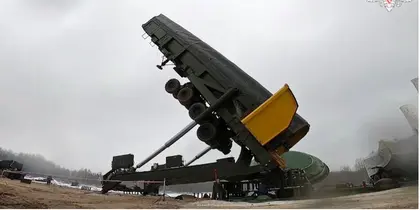The Russian defense ministry broadcast a video of its troops transporting a missile to a launch silo, slowly raising it into vertical position and then lowering into a silo shaft, Reuters reported Thursday.
The video, broadcast on Zvezda TV, was said to be shot at the Dombarovsky missile base in the Orenburg region near Kazakhstan. The missile was said to be fitted with an Avangard hypersonic glide vehicle (HGV) warhead.
JOIN US ON TELEGRAM
Follow our coverage of the war on the @Kyivpost_official.
This demonstration occurred almost exactly a year after a similar broadcast on Nov. 18, 2022, the narration of which doubled down on the claim that the Avangard missile was “impossible to intercept” – just as had been said about its Kinzhal, before Ukraine intercepted several during attacks on Kyiv.
According to Russian President Vladimir Putin, the US 2002 withdrawal from the ABM Treaty forced Russia to start developing hypersonic weapons.
He said: “We had to create these weapons in response to the US deployment of strategic missile defense systems, which in the future would be capable of virtually neutralizing our nuclear potential.”
The Avangard missile system – billed as being able to fly at speeds of up to Mach 27 – was one of six “next generation” weapons unveiled by Putin during his Presidential Address to Russia’s Federal Assembly in Moscow in March 2018.
He has repeatedly stated since then that he is developing hypersonic weapons to ensure Russian strategic forces can defeat current and future US air and missile defenses.

Russian Military: Bring Friend, Earn Bonus
The “super weapons” were the Avangard HGV, the Burevestnik nuclear-powered cruise missile, the Zircon and Kinzhal hypersonic missiles, the Poseidon unmanned underwater vehicle, and the Sarmat super-heavy ICBM.
Development of the Avangard
Russian research into hypersonic warheads began under the Soviet Union in the 1980s, which was expanded in the mid-1990s with the designation “Project 4202.”
Ironically, further development was delayed because of Russia’s 2014 military invasion of Ukraine as critical components for the HGV’s control systems were of Ukrainian design and manufacture.
This forced Russia to launch research and development into a replacement.
The re-engineered Avangard HGV was test fired In December 2018 from the Dombarovsky missile base. It was fitted to SS-19 Inter-Continental Ballistic Missile (ICBM) which carried it more than 6,000 kilometers before it hits its target in the Kura shooting range in Kamchatka.
Russia’s Defense Ministry announced, via the TASS state news site in December 2019 that it had deployed its first Avangard-equipped operational regiment to the Dombarovsky missile base.
Russian Defense Minister Sergei Shoigu announced at the same time that the defense forces would deploy “31 launchers [equipped] with the Yars and Avangard ICBMs” on combat duty with the Strategic Missile Forces.
Avangard Technical Specifications
Russia claims that Avangard’s range is more than 6,000 kilometers (3,728 miles), weighs around 2,000 kilograms (4,400 pounds), with either a 2-megaton nuclear or conventional high explosive warhead.
The Avangard is carried on an intercontinental ballistic missile, currently the RS-18A ICBM (NATO reporting name SS-19 Stiletto), which will in time be replaced by the R-28 “Sarmat/ Satan II.
The HGV is carried to a sub-orbital altitude of around 100 kilometers (62 miles) by the carrier missile before being released.
It then enters into a “cruise mode” before re-entering the atmosphere and accelerating to claimed speeds of between Mach 20 and Mach 27. It is said to be able to maneuver at these speeds and constantly alter its trajectory making interception extremely complicated.
According to the Center for Strategic and International Studies missile threat project, there are no publicly available images of the Avangard HGV other than “artist’s impressions,” which suggest it is “a short wedge-shaped design” which does not contain a separate propulsion system, relying on gravity and its aerodynamic features to maintain velocity after an initial boost.
You can also highlight the text and press Ctrl + Enter






